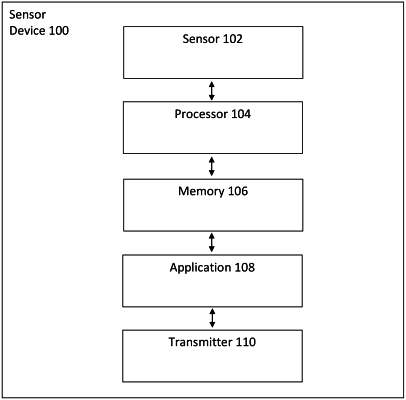| CPC A61B 5/11 (2013.01) [A61B 5/02416 (2013.01); A61B 5/1116 (2013.01); A61B 5/1121 (2013.01); A61B 5/6833 (2013.01); G01P 21/00 (2013.01); A61B 5/024 (2013.01); A61B 2560/0223 (2013.01); A61B 2562/0219 (2013.01)] | 16 Claims |

|
1. A method of calibrating a sensor associated with a subject, comprising:
producing, by the sensor, a sensor vector V associated with a body acceleration of the subject relative to a gravity vector;
calibrating the sensor vector V, including:
processing the sensor vector V with the subject at a first elevation angle relative to a reference to produce a first calibrated sensor vector VS, wherein the processing of the sensor vector includes:
determining an angle α and applying rotational matrix R1 to the sensor vector V, wherein the rotational matrix R1 is an XY rotation for α° around a Z axis,
determining an angle β and applying rotational matrix R3 to the sensor vector V, wherein the rotational matrix R3 is a YZ rotation for β° around an X axis,
obtaining user input on an orientation of the sensor with reference to a midline of the body and determining an ideal upright sensor vector Vu,
determining rotational matrix Rs by the product of the rotational matrix R3 and the rotational matrix R1, wherein the rotational matrix Rs, is an intermediate rotational matrix,
applying the rotational matrix Rs rotation to the ideal upright sensor vector Vu to obtain a rotated ideal upright sensor vector V′u, and
determining an angle ζ using V′u and applying the rotational matrix R2 to the sensor vector V to obtain the first calibrated sensor vector VS wherein the rotational matrix R2 includes an XY rotation for ζ° around the Z axis;
determining a second elevation angle η associated with elevation of the subject relative to the reference, wherein the determining of the second elevation angle η includes:
determining an angle δ and rotational matrix Ry, wherein the rotational matrix Ry is an XZ rotation for δ° around a Y axis,
applying the rotational matrix Ry rotation to the sensor vector V to obtain XY, wherein XY is the rotated vector on an XY plane,
determining an angle γ using reference to XY and an ideal gravity vector on supine Gs, and
obtaining the sensor elevation angle η as a function of γ;
determining rotational matrix Rx, by rotating an YZ plane of the sensor vector V for η° around the X axis;
calculating a second calibrated sensor vector VSη as a function of Rx, and the first calibrated sensor vector VS; and
determining a physiological or physical assessment of the subject using the second calibrated sensor vector Vsη.
|